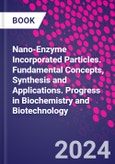Nano-Enzyme Incorporated Particles: Fundamental Concepts, Synthesis and Applications focuses on integrative approaches of the enzyme nanoparticle synthesis and its applications on biomedicine, biosensors and biocatalysis. The book discusses the vital activities of nanozymes in enzyme mimicking processes and covers the latest methods and procedures involved. Divided into five sections, this book covers the production and characterization of enzyme nanoparticles, the activities, properties, and applications of enzyme nanoparticles, the development of nanocatalysts as analytical tools, and the degradation of nanoparticles. It covers potential investigations regarding aspects of production, characterization, and applications of enzyme incorporated nanoparticles.
Table of Contents
Section 1 Production and characterization of enzyme nanoparticles1. Preparation and characterization of Enzyme nanoparticles
2. Nanomaterials as enzyme immobilization matrix
Section 2 Activities of enzyme nanoparticles
3. Enzyme like activity of nanozymes, the enzyme mimics
4. Various activities on the enhancement of nanobiocatalysts
Section 3 Properties and applications of enzyme incorporated nanoparticles
5. Comparison of the positive and negative properties of natural enzymes and nanoenzymes
6. Microbial sources and applications of enzyme incorporated nanoparticles
7. Potential challenges of enzyme incorporated nanoparticles towards environmental applications
8. Industrial applications of nanoparticle immobilized enzymes
Section 4 Development of nanocatalyst
9. Integrated approaches on development of nanobioacatalyst and its bioprocessing applications
10. Enzyme based biosensors with nanoparticles as analytical tools
Section 5 Degradation of nanoparticles
11. Potential degradation of nanomaterials by enzymes








